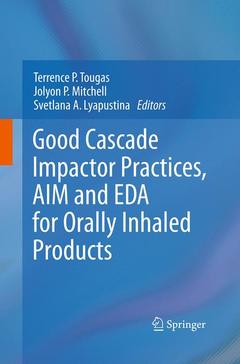Description
Good Cascade Impactor Practices, AIM and EDA for Orally Inhaled Products, Softcover reprint of the original 1st ed. 2013
Coordinators: Tougas Terrence P., Mitchell Jolyon P., Lyapustina Svetlana A.
Language: English
Keywords
AIM; Inhale; Lyapustina; Oral; Product
Publication date: 08-2016
Support: Print on demand
Publication date: 04-2013
442 p. · 15.5x23.5 cm · Hardback
Description
/li>Contents
/li>Biography
/li>Comment
/li>
Introduction.- Current Approaches To APSD Measurement of OIPs Based on Inertial Impaction.- Physical Causes of APSD Changes in Aerosols From OIPs and their Impact on Cascade Impactor Measurements.- Good Cascade Impactor Practices.- The AIM and EDA Concepts: Why they are Needed.- Product Lifecycle Approach to Cascade Impaction Measurements.- Theoretical Basis for the EDA Concept.- Performance Characterization of EDA and its Potential to Improve Decision Making in Product Batch Release.- Verification of the EDA Concept through an Assessment of Theoretical Failure Modes, Failure Mode Analysis and Case Studies with Real Data.- Validating AIM-Based Instrumentation and Associated Measurement Techniques.- The Regulatory and Compendial Acceptance Pathways for AIM and EDA.- Applying the AIM Concept in Support of Developing Improved In Vitro-In Vivo Relationships for OIPs.- Future Directions for the AIM and EDA Concepts.- Conclusions.
Terrence P. Tougas, Ph.D.
Terrence Tougas, Ph.D. is a Highly Distinguished Research Fellow in Analytical Development at Boehringer Ingelheim Pharmaceuticals, Ridgefield, CT where he has over 20 years of experience and currently heads the Stability, Submission Documents and Information Systems Group. He contributed to chemistry, manufacturing and controls sections of several New Drug Applications, including for pulmonary (metered dose inhalers, inhalation solutions and nasal sprays) and antiviral products.
Dr. Tougas is a member and past chair of the International Pharmaceutical Aerosol Consortium on Regulation and Science (IPAC-RS) Board of Directors, and has been leader or member of several IPAC-RS working groups. Dr. Tougas served on the Steering Committee and chaired the Drug Product Technical Committee of the Product Quality Research Institute (PQRI). More recently, he helped form the International Consortium on Innovation and Quality in Pharmaceutical Development (IQ), served as the first chair of its Board of Directors and is a member of the IQ Statistics Leadership Group.
Dr. Tougas authored numerous publications related to the CMC aspects of drug development, analytical chemistry and quality control statistics. He contributed chapters to books on chromatography and leachables/extractables testing of inhalation products. His background is in analytical chemistry; he holds a Ph.D in chemistry from the University of Massachusetts, Amherst.
Jolyon P. Mitchell, Ph.D.
Jolyon Mitchell, Ph.D. is Scientific Director at Trudell Medical International, London, Canada. He is involved in several industry-wide organizations involved with inhaled medical aerosol delivery, in particular the European Pharmaceutical Aerosol Group (EPAG) as well as serving as a Scientific Adviser to IPAC-RS. He played major parts in the development of an international standard (ISO 20072:2009) covering the design verification of portable inhaler
Introduces a new, simpler and more effective way in which to interpret pharmaceutical aerosol particle size data from orally inhaled products (OIPs)
Outlines a comprehensive product lifecycle management strategy in terms of in vitro characterization of APSD
It leads those working with CIs or CI data to adopt more efficient approaches in their practice
Includes supplementary material: sn.pub/extras




